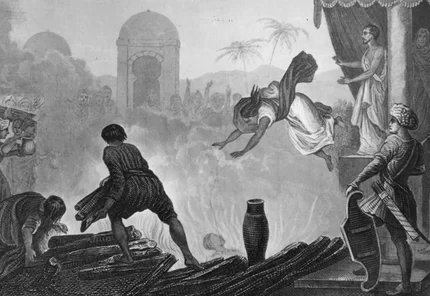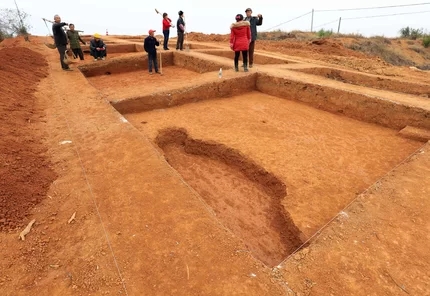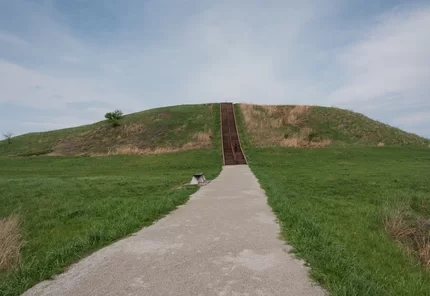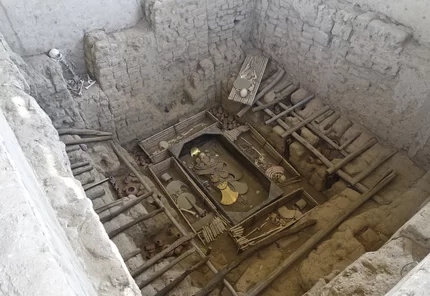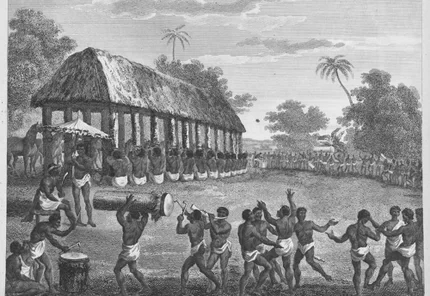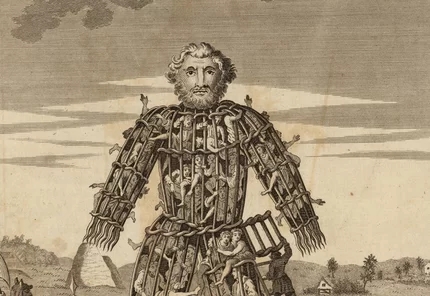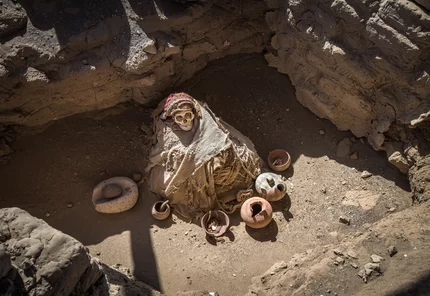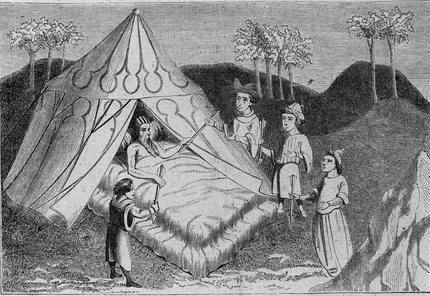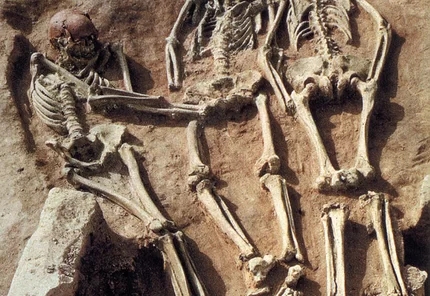DepthReading
25 Cultures That Practiced Human Sacrifice
Summary: From prehistory to the 21st century, human sacrifice has been practiced around the world by numerous cultures. Live Science takes a look at 25 cultures that practiced, or still practice, human sacrifice.
Human sacrifices
From prehistory to the 21st century, human sacrifice has been practiced around the world by numerous cultures. Live Science takes a look at 25 cultures that practiced, or still practice, human sacrifice.
Photo Credit: Hulton Archive/Getty Images
China sacrifice
Human sacrifice was practiced in China for thousands of years. At a 4,000-year-old cemetery near modern-day Mogou village in northwestern China, archaeologists found hundreds of tombs, some of which held human sacrifices. One sacrificed victim was around 13 years old. Archaeologists have also found thousands of human sacrifices at Shang Dynasty (1600 – 1040 B.C.) sites in the modern-day city of Anyang.
The practice of human sacrifice seems to have stopped or become very rare by the time China was unified in 221 B.C. by Qin Shi Huang, the first emperor of China. The first emperor's Terracotta army, made up of thousands of life-size clay warriors, allowed him to take an army with him to the afterlife without sacrificing real-life warriors.
Photo Credit: Shutterstock
City of Ur
The Great Death Pit at the ancient city of Ur, in modern-day Iraq, contains the remains of 68 women and six men, many of which appear to have been sacrificed. Dating back about 4,600 years, a variety of fantastic treasures, including a statuette known as the Ram in the Thicket, which is made of silver, shell, gold, lapis lazuli and carnelian, were found in the death pit. Archaeologists believe that the pit was used to bury Ur's rulers.
Photo Credit: University of Pennsylvania Museum of Archaeology and Anthropology
Mound 72
A 10-foot (3 meters) mound called Mound 72 by modern-day archaeologists holds the remains of 272 people, many of them sacrificed. It is located at Cahokia, a city located near modern-day St. Louis that flourished from A.D. 1050 to 1200.
The archaeology of the mound is complex, but it appears as if people were sacrificed gradually in a series of episodes. In one episode, 52 malnourished women ages 18 to 23, along with a woman in her 30s, were sacrificed at the same time. In another episode, it appears that 39 men and women were clubbed to death. The mound also holds the remains of two individuals who were buried with 20,000 shell beads. It's possible that some or all of the sacrifices were dedicated to the two individuals.
Photo Credit: Shutterstock
Inca child mummies
The Inca flourished during the 15th ccentury A.D., conquering large swaths of territory in the Andes and connecting it with a vast system of roads. The Inca also practiced child sacrifice; their mummies have been found by archaeologists, often near the summit of mountains or volcanoes.
In one famous example, three child mummies were found near the remains of a shrine at Mount Llullaillaco — a 22,100-foot-tall (6,740 meters) active volcano on the border of Chile and Argentina. Researchers found that in the year before they died they were "fattened up" with a diet of maize and dried llama meat; and before their death, they were given maize beer and coca leaves. How exactly they were killed is unknown.
Maya sacrifice
The ancient Maya practiced human sacrifice on special occasions. These sacrifices were sometimes conducted in their temples, and many of the victims may have been prisoners of war. At the ancient city of Chichen Itza, victims were painted blue, in honor of the rain god Chaak, before being sacrificed and thrown into a well.
Some archaeologists believe that Maya ball games would, on rare occasions, end with members of the losing or winning team being sacrificed. Evidence for these sacrifices is mainly found in depictions of Maya art, and not all archaeologists interpret the images as representing the sacrifice of a ball team.
Photo Credit: Shutterstock
Ancient Israel
The Hebrew Bible mentions human sacrifice being carried out by Israelites several times; however, researchers do not agree on how often the practice occurred or whether it took place at all. Perhaps the most famous biblical story is that of Abraham who, in the book of Genesis, was told by God to sacrifice his son Isaac. Before the deed is done, God stops him and tells Abraham that he was only testing him.
Whether the stories in the Hebrew Bible indicate that human sacrifice actually occurred in ancient Israel is a source of debate among researchers. Unless clear archaeological evidence is found it's unlikely that the debate will ever be resolved.
Photo Credit: Charles Foster
Aztec civilization
The Aztec civilization in Mexico was centered at the ancient city of Tenochtitlán, in what is now Mexico City, and flourished during the 14th and 15th centuries A.D. Artistic, archaeological and textual records indicate that human sacrifices occurred with some regularity at Tenochtitlán, particularly at the Templo Mayor, one of the largest temples in the city, where the remains of Tzompantli (skull racks) have been found.
The Spanish conquered the Aztecs during the 16th century, bringing with them diseases that decimated the population. The Spanish sometimes used the Aztec practice of human sacrifice to try to justify their conquest of the Aztecs.
Photo Credit: Hulton Archive/Getty Images
Ancient Egypt
Human sacrifice occurred around 5,000 years ago during Egypt's early history. Human sacrifices have been found by the graves of early pharaohs at Abydos, a city in southern Egypt that served at times as Egypt's capital and was the cult center for Osiris, the god of the underworld. The practice appears to have become less common or completely phased out by the time the Giza pyramids were built around 4,500 years ago.
Photo Credit: Bilwissedition Ltd. & C. KG/Alamy
Stonehenge
The skeleton of a man found buried in a ditch at Stonehenge has been interpreted by Jacqueline McKinley, an osteoarchaeologist with Wessex Archaeology, as a sacrificial victim. The man, who McKinley said was 5 foot 10 inches and had a robust muscular build, was shot repeatedly with arrows. McKinley interprets the location of his burial and nature of his execution as indicating that he was killed as part of a human sacrifice. Her research was featured in 2014 in a Smithsonian channel documentary showing a re-creation of his sacrificial execution.
Stonehenge was constructed between roughly 5,000 and 4,000 years ago, and was part of a sacred landscape that included shrines, burials and additional circles made of stone or wood. Not all archaeologists are convinced that human sacrifice took place at Stonehenge, but future research into the nearby landscape and its burials may help resolve the debate.
Photo Credit: Chris Wood/Express/Getty Images
Hitobashira
Depending on how the term human sacrifice is defined, the kamikaze pilots who tried to crash their planes into Allied ships during World War II could be defined as human sacrifices. Their planes sometimes had images of cherry blossoms, which historically symbolized a samurai who gave his life for the emperor.
Another examples of human sacrifice can be found in the stories of Hitobashira — human sacrifices found within the walls or floors of important structures like castles. How often this practice occurred and which structures actually had human sacrifices built within them is a matter of debate. According to legend, Maruoka Castle (constructed in 1576) contains the sacrifice of a peasant woman named Oshizu, who agreed to be sacrificed so that her son could become a member of the samurai class.
Photo Credit: Shutterstock
Hawaii clubbing?
Human sacrifices were performed in Hawaii as late as the 19th century. It may have served as a way for elite members of the island to help maintain their control over the population. Europeans who visited the island recorded the practice, with one famous painting showing a person being clubbed to death while lying on a rock. It's possible, however, that these accounts were exaggerated as a way to depict Hawaiian culture as savage and justify desires by Europeans and Americans to control the island.
Archaeologists have found that, as early as A.C. 1300, temples in Hawaii were being built with altars where sacrifices, either of humans or animals, could be made.
Photo Credit: Jacques Arago
Ancient Romans
Ancient Roman writers claimed that human sacrifices were made during Rome's early history. After the Romans were defeated at the Battle of Cannae in 216 B.C., a battle that allowed an army from Carthage to temporarily occupy a large part of Italy, the Romans resorted to human sacrifice. "A Gaulish man and a Gaulish woman and a Greek man and a Greek woman were buried alive under the Forum Boarium," wrote the Roman writer Titus Livius (died A.D. 17) in his book "History of Rome" (translation by Canon Roberts).
Photo Credit: Shutterstock
Greeks sacrificed to Zeus
Textual references and archaeological remains indicate that the ancient Greeks, at times, practiced human sacrifice. In 2016, a 3,000-year-old skeleton of a male teenager was found at an altar dedicated to Zeus at Mount Lykaion in Greece. Archaeologists believe that the teen may have been sacrificed to Zeus, an idea supported by ancient texts that tell of child sacrifices that were made on the mountain.
Photo Credit: Hellenic Ministry of Culture, Education and Religious Affairs
Moche sacrifice
The Moche, who flourished in Peru between roughly the first and eighth centuries A.D., frequently practiced human sacrifice. They placed the victims in tombs and temples. At a temple now called Huaca de la Luna (Shrine of the Moon), the remains of dozens of sacrificed individuals have been discovered.
Photo Credit: Shutterstock
Dahomey kingdom
Human sacrifice was practiced by the rulers of the West African kingdom of Dahomey, which flourished between roughly A.D. 1600 and 1894, when the French conquered it and incorporated it into their empire. How widely human sacrifice was practiced is a matter of debate. Nineteenth-century European and American accounts sometimes claimed that more than 1,000 people could be sacrificed at any one time. Modern-day researchers believe that the actual number was quite a bit lower.
Photo Credit: Archibald Dalzel/NYPL
Celtic sacrifices?
The Celts are a name for a variety of groups who thrived throughout Europe, and parts of the Middle East, during ancient and modern times. Celtic groups gradually converted to Christianity after the first century A.D. Ancient Roman writers claimed that the Celts practiced human sacrifice on a large scale before they converted to Christianity and that their human sacrifices were sometimes carried out by the Druids, a people who served a variety of roles, sometimes performing religious functions in Celtic groups.
Modern-day archaeologists doubt that human sacrifice was practiced on a large scale by the Celts, if it was performed at all. Researchers point out that the Gauls, one of the largest Celtic groups, was conquered by the Romans, giving them an incentive to portray the Gauls as savages who would benefit under Roman rule. In 2015, a large 2,500-year-old Celtic tomb, possibly of a prince, was discovered that yielded many fantastic treasures; however, no human sacrifices were found.
Photo Credit: Thomas Pennant/National Library of Wales
The Nazca
The Nazca culture flourished in Peru between roughly 100 B.C. and A.D. 800. They are famous for constructing the Nazca Lines, thousands of geoglyphs scratched on the desert floor that show geometric designs as well as images from the natural world and human imagination. While most famous for their geoglyphs, the Nazca also practiced human sacrifice; Archaeologists have found the remains of trophy heads, as they call them, at several Nazca sites. Archaeologists believe that many of these trophy heads come from prisoners, who were executed and then had their heads chopped off.
Photo Credit: Shutterstock
Vikings sacrificed slaves
The Vikings occasionally sacrificed slaves after their owner had died. In Flakstad, Norway, archaeologists found the burial of 10 people, some of whom were beheaded. Analysis of their diet revealed that the beheaded individuals consumed more fish-based protein and those with their heads on consumed more protein from dairy and land-based animals. The team believes that the beheaded individuals were likely sacrificed after the death of their owners.
The remains of five human sacrifices, four of them young children, have also been discovered at the Viking fortress at Trelleborg in Denmark. The fortress dates back about 1,000 years; however archaeologists with the National Museum of Denmark believe that at least some of the victims were sacrificed sometime before the fort was constructed.
Photo Credit: PBS
Carthage infants
Carthage is an ancient city in modern Tunis, in North Africa. Founded by the Phoenicians, a seafaring people who originated in the Eastern Mediterranean, the city contains a controversial burial ground known as the Tophet (the name comes from the Hebrew Bible), which has thousands of urns containing the cremated remains of infants. Some researchers believe that many of the infants were sacrificed, a claim supported by writings from ancient Greek and Roman historians. However, in 2012, a study of the skeletal remains found that few if any of the infants were sacrificed, a finding that some researchers dispute.
Photo Credit: Shutterstock
Mongol invaders
At their peak around 700 years ago, the Mongols controlled a vast amount of territory that stretched from East Asia to Europe. Most of the surviving accounts of the Mongols come from people the Mongols conquered, fought against or otherwise had hostilities with. Some of these accounts claim that the Mongols practiced human sacrifice. How often the Mongols undertook human sacrifice, or if it was practiced at all, is a matter of debate among researchers.
Photo Credit: Hulton Archive/Getty Images
Prehistoric Europe
In a study published in 2007 in the journal Current Anthropology, researchers described evidence that human sacrifice may have been practiced by hunter-gatherers in Europe as far back as the Upper Paleolithic (26,000 to 8,000 B.C.). The researchers found that the rate of multiple burials (two or more people buried at the same time) was unusually high during the Upper Paleolithic, about one in five.
Some of these multiple burials were unusual, raising questions as to whether the individuals died naturally or in an accident. For instance, in the Czech Republic, three children were found buried together in a bizarre arrangement. One child was buried with its face down while another was buried with its hand touching the public region of another child, an unusual treatment that raises the question of whether the children died naturally or were sacrificed as part of a ritual, archaeologists said.
Photo Credit: Bohuslav Klim
Ancient Korea
Human sacrifice was practiced in some ancient Korean kingdoms. In May 2017, archaeologists found the remains of two skeletons beneath the walls of Moon Castle in Gyeongju, the capital of the kingdom of Silla. The sacrifices date back about 1,500 years. Archaeologists are not sure exactly how they were killed; however, they believe that they were sacrificed before construction of the castle in order to ensure that the castle functioned well. Additionally, human sacrifices have been found in the tombs of ancient Korean kings and nobility.
Photo Credit: Shutterstock
Indus Valley civilization
The Indus Valley Civilization (sometimes called the Harappan civilization) was centred in modern-day Pakistan and flourished for centuries before succumbing to climate change about 4,000 years ago. The civilization had a writing system that is undeciphered, but the images left beside their texts can provide a great deal of information. At Mohenjo-Daro, one of the civilization's largest cities, a seal found about 80 years ago contains text and numerous images including of a person kneeling before what may be a deity. Next to the kneeling person there is a human head on a stool, evidence that this civilization may have practiced human sacrifice.
Not all archaeologists agree that the seal shows a human head but, if the identification is correct, it would provide evidence that human sacrifice was practiced by this civilization. Future excavations of remains of the Indus Valley civilization and the decipherment of their writing system may provide more evidence.
Photo Credit: Shutterstock
India funeral pyres
Sati is an ancient Hindu ritual where a woman chooses (or is coerced) to leap onto the funeral pyre of her husband after he has died. Today the practice is outlawed, but on very rare occasions, it still occurs. In 2006, BBC news reported that a woman, reportedly in her 40s, leapt onto the funeral pyre of her husband.
Photo Credit: Hulton Archive/Getty Images
Tanzania
The ritual sacrifice of people with albinism, a condition that leaves someone without pigment in their skin or hair, has been an ongoing problem in the east African nation of Tanzania.
Some individuals in the country believe that rituals that involve the sacrifice of albinos, or use of their body parts, can bring good fortune. The Guardian reported in 2015 that Tanzanian officials had arrested 32 "witch doctors" who were allegedly involved in the rituals or trade in body parts.
Photo Credit: Shutterstock
Category: English
DepthReading
Key words:

